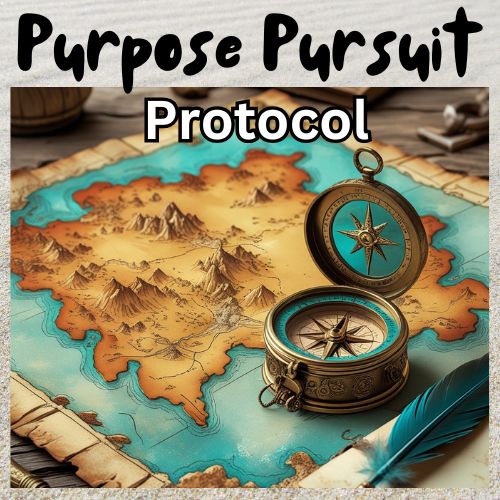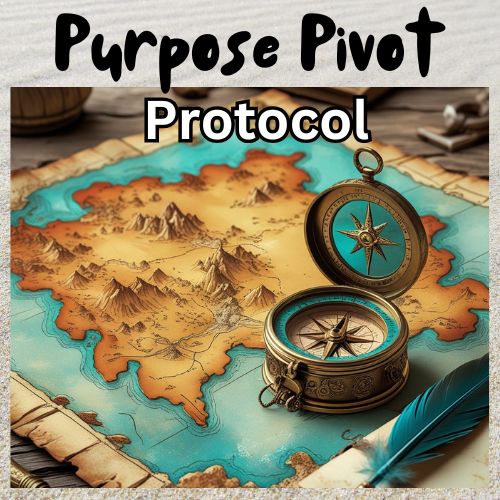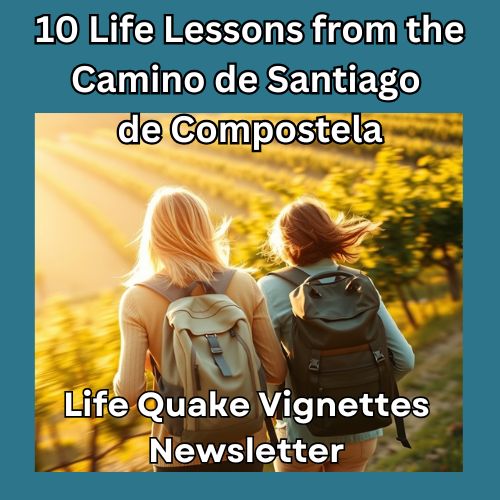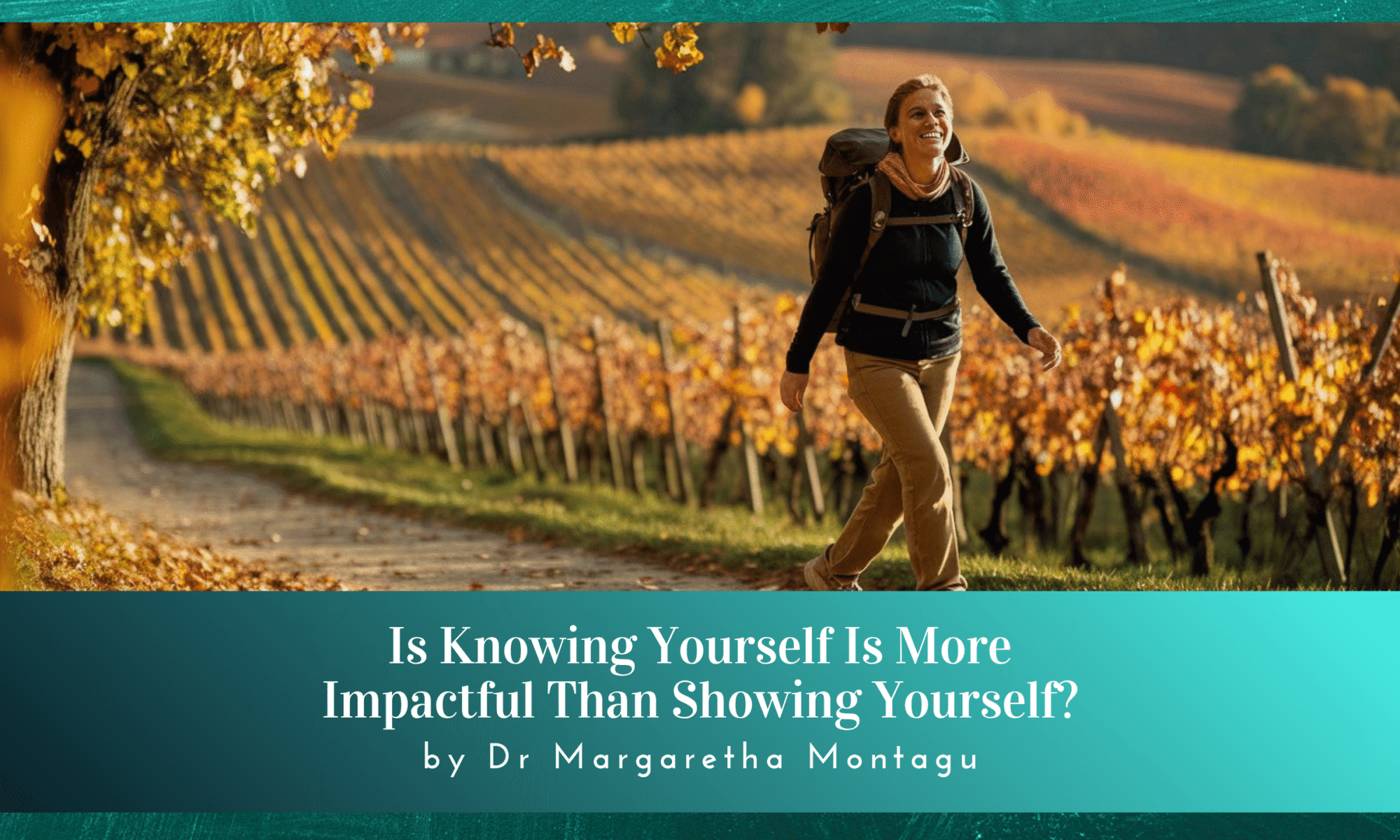Discover How Quieting the Noise and Turning Inward Can Transform Your Relationships
What this is: A deep dive into James Clear’s wisdom on why understanding yourself matters more than broadcasting yourself, especially for high-achievers who’ve mastered the art of performance but may have lost touch with their inner compass.
What this isn’t: Another productivity hack, a call to suppress your voice, or advice to become a wallflower at networking events.
Read this if: You’re successful on paper but exhausted in reality. You’ve perfected your LinkedIn profile but can’t remember the last time you checked in with your actual self. You’re curious whether authenticity might mean something different than you thought.
Five Key Takeaways
- Self-awareness is the foundation upon which authentic self-expression is built. Without it, you’re broadcasting someone else’s script.
- High achievers often confuse performing well with knowing themselves well. Success can become the perfect camouflage for self-ignorance.
- True authenticity requires the courage to face uncomfortable truths about yourself before sharing anything with the world.
- Self-awareness isn’t a destination but a practice, one that becomes more vital as your responsibilities and influence grow.
- The most powerful leaders aren’t those who express themselves the loudest, but those who understand themselves the deepest.
Self-awareness: the foundation of Emotional Intelligence
We live in the age of the personal brand. Your thoughts on Twitter, your wins on LinkedIn, your breakfast on Instagram. Self-expression has become currency, and silence feels like career suicide. But here’s the uncomfortable truth that James Clear articulated so perfectly: “self-awareness is more important than self-expression.”
Wait. More important? In a world that rewards the loudest voice in the room?
Yes. Especially then.
When you’re climbing the ladder, building the business, or crafting the perfect public persona, you can express yourself brilliantly without actually knowing yourself at all. You can curate a flawless image whilst your inner world remains unexplored territory. You can build an empire on foundations you’ve never examined.
And one day, usually at 3 a.m. or in the middle of what should be your greatest triumph, you’ll wonder: Who am I when no one’s watching?
This article isn’t about becoming less. It’s about becoming real. And that journey, as I have witnessed over two decades of medical practice and fifteen years of hosting transformative stress management retreats along the Camino de Santiago, always begins with the courage to look inward before speaking outward.









The Disturbing Story of Catherine Ashford-Wells
Catherine Ashford-Wells had perfected the art of presence. At forty-three, she was the kind of woman who commanded boardrooms with a single raised eyebrow. Her TED talk on innovative leadership had 2.3 million views. Her consultancy firm employed seventy-two people across three continents. When she spoke at conferences, people leaned forward, pens poised, desperate to capture her insights.
She knew exactly what to say, when to pause for effect, how to modulate her voice for maximum impact. Self-expression? She’d weaponised it.
Her first panic attack was on a Wednesday.
Catherine was mid-presentation to a potential client, a pharmaceutical giant that could triple her revenue. She was forty minutes into her pitch, riding the familiar high of a room falling under her spell, when her chest tightened. Not gradually. Suddenly. As if someone had wrapped steel bands around her ribs and was twisting them tighter with each breath.
The PowerPoint slide behind her showcased her company’s core values. Authenticity. Innovation. Trust.
The irony wasn’t lost on her, even as black spots danced at the edges of her vision.
She excused herself. Walked calmly to the ladies’ room. Locked herself in a stall. And wept so hard she thought she might vomit.
The fluorescent lights hummed overhead, sterile and indifferent. The scent of industrial-strength air freshener, trying and failing to mask something unpleasant, filled her nostrils. Her silk blouse, £340 from Harvey Nichols, stuck to her back with sweat. She could taste copper in her mouth, that metallic tang of adrenaline and fear. Her hands trembled as she gripped the cold chrome of the handrail, the metal biting into her palms.
Catherine had no idea who she was.
She knew her elevator pitch. Her mission statement. Her carefully crafted origin story about building a business from her kitchen table (true, but edited of all the messy bits). She could tell you her values, her vision, her five-year plan.
But sitting on that toilet seat in a five-star hotel, mascara tracking down her cheeks, she realised something terrifying: she’d become a collection of perfectly rehearsed responses to other people’s expectations.
The woman in the boardroom? Confident, decisive, slightly intimidating but ultimately approachable. The mother at school pick-up? Warm, present, appropriately interested in bake sales whilst subtly establishing she was Too Busy for committee work. The wife across the dinner table? Supportive, successful enough to be impressive but not so successful her husband felt diminished. The daughter on Sunday phone calls? Grateful, accomplished, proof that the sacrifices had been worth it.
But Catherine? The actual human being beneath all those performances?
She didn’t have a clue.
The thought felt like standing at the edge of a cliff in dense fog, unable to see either the ground beneath her feet or the drop ahead. Her heart hammered against her ribs, a trapped bird hurling itself against the cage. She pressed her forehead against the cool stall door, breathing in the smell of cleaning products and other people’s perfume, and thought: I have expressed myself into oblivion.
Three months later, Catherine found herself in the south-west of France, hiking the Camino de Santiago with a group of strangers at Dr Margaretha Montagu’s farm. She’d signed up in a moment of desperation, typing her credit card details at 2 a.m., convinced she’d cancel before the date arrived.
She didn’t cancel.
On the third day of walking, feet blistered, stripped of her usual armour of designer suits and corporate confidence, Catherine simply walked. No performance. No audience. Just breath, steps, and the sound of gravel crunching beneath her boots. A landscape that didn’t care about her LinkedIn profile. Wind that tousled her hair without asking permission.
For the first time in years, she stopped expressing and started listening. To herself. To the terrifying silence where opinions usually rushed in. To the parts of her that had been waiting, so patiently, to be noticed.
That’s when the real work began.
Why Self-Awareness Is Essential
What Exactly Is Self-Awareness, and Why Does It Matter?
Self-awareness isn’t navel-gazing or endless therapeutic introspection (though therapy can certainly help you get there). It’s the capacity to observe yourself objectively, to recognise your patterns, to understand your triggers, to acknowledge your shadows alongside your shine.
Think of it as internal data collection. You wouldn’t make a business decision without reliable data, would you? Yet we make life-altering choices, build relationships, choose careers, and parent children without ever gathering accurate information about our own operating systems.
Self-awareness means knowing:
- Your actual values (not the ones you think you should have)
- Your genuine triggers (not the reactions you’ve learned to perform)
- Your real needs (not the desires you’ve been conditioned to pursue)
- Your authentic responses (not the socially acceptable alternatives)
When James Clear emphasises self-awareness over self-expression, he’s highlighting a crucial sequence: know thyself before showing thyself. Because authentic self-expression, the kind that builds genuine connection and lasting impact, can only emerge from a foundation of honest self-knowledge.
The Inner Camino philosophy, central to my approach over eight published books on navigating life’s major transitions, recognises that external journeys mean little without internal ones. You can walk a thousand miles and arrive nowhere if you haven’t also travelled inward.
How Do High You Confuse Competance with Self-Knowledge?
It’s a trap: success rewards competence. And competence, especially in professional settings, often means suppressing or sublimating personal responses in favour of strategic ones. You learn to respond, not react. To project confidence when you feel uncertain. To make decisions when you’re terrified. To lead when you want to hide.
This is valuable. Necessary, even. The problem emerges when the performance becomes so seamless you forget there’s a performer underneath.
Consider these scenarios, familiar to many executives and entrepreneurs:
- You’re brilliant at reading the room but have lost touch with how you actually feel
- You can articulate your company’s mission with passion but struggle to identify your own purpose
- You’re decisive in crisis but paralysed by personal choices
- You inspire others effortlessly but feel increasingly empty
- You’ve mastered emotional intelligence in the service of others whilst ignoring your own emotional landscape
This isn’t weakness. It’s what I, drawing on decades of experience as a physician specialising in stress management, calls “competence trauma”, the wound we sustain from becoming too good at functioning without feeling, performing without presence, achieving without awareness.
Your success has taught you to override your internal signals. Self-awareness is about learning to receive them again.
What’s the Relationship Between Authenticity and Self-Awareness?
Let’s untangle these two concepts that often get conflated.
Authenticity without self-awareness is just impulsive behaviour dressed up in empowerment language. It’s “speaking your truth” when you haven’t examined whether that truth is yours or something you absorbed from your family, culture, or the last business book you read. It’s “being real” when you don’t actually know what’s real about you versus what’s reactive, defensive, or conditioned.
True authenticity requires the groundwork of self-awareness. It’s the difference between:
Reactive expression: “I just say what I think, that’s who I am.” Authentic expression: “I understand my patterns well enough to recognise when I’m defensive versus when I’m genuinely responding from my values.”
Unexamined sharing: Broadcasting every thought and feeling as they arise. Conscious communication: Sharing what serves connection and growth because you understand yourself well enough to know the difference.
Performing vulnerability: Crafting carefully curated stories of struggle for strategic impact. Genuine transparency: Sharing from a place of integrated understanding about your journey.
My work has shown repeatedly that authenticity isn’t about volume or frequency of expression. It’s about accuracy. And accuracy requires awareness.
Can Self-Expression Actually Obstruct Self-Awareness?
Paradoxically, yes. And it’s happening more than ever in our hyperconnected world.
When you’re constantly expressing, crafting posts, sharing updates, contributing opinions, you’re externally focused. Your attention is directed outward, towards reception, reaction, engagement. You’re monitoring how your expression lands rather than investigating where it originates.
Social media has turned self-expression into a competitive sport. But in the race to have the hottest take, the most inspiring quote, the most vulnerable confession, we’ve lost the contemplative space where self-awareness grows.
Self-awareness requires:
- Silence (internal and external)
- Reflection (not just on events but on your responses to events)
- Honesty (especially about things you’d rather not admit)
- Time (you can’t rush understanding)
- Solitude (sometimes you need to be alone with yourself)
These practices don’t generate content. They don’t build your platform. They won’t increase your followers. But they will, gradually and profoundly, introduce you to yourself.
The storytelling circles that form a cornerstone of my retreats (with thirty-plus testimonials from guests on my website, testament to their transformative power) create protected spaces where expression serves awareness rather than performance. Where sharing becomes a tool for self-discovery rather than self-promotion.
The Ripple Effect: How One Person’s Self-Awareness Can Transform a Community
Catherine’s story didn’t end with personal transformation (though that would have been enough). Six months after her Camino experience, her consultancy looked different. Not smaller or less successful, but more aligned.
She’d let go of three major clients whose values genuinely conflicted with hers (not the values on her website, but the ones she’d discovered she actually held). She’d restructured her team to allow for more flexible working, not because it was trendy, but because she’d realised her own creativity suffered under rigid schedules.
She started speaking less at conferences but saying more when she did. Her presentations became conversations. Her advice became questions. Her certainty became curiosity.
Most significantly, she created space for her team to develop their own self-awareness. Leadership meetings included ten minutes of silence before strategic discussions. Performance reviews asked “What did you learn about yourself this quarter?” alongside traditional metrics.
Two team members used their new awareness to recognise they were in the wrong roles (and wrong industry). Catherine supported their transitions. Three others discovered strengths they’d been suppressing. The company culture shifted from high-performance theatre to sustainable authenticity.
Her teenage daughter, who’d been increasingly withdrawn, started opening up. Not because Catherine was suddenly expressing herself more, but because she was finally present enough to truly listen. To receive without immediately responding. To witness without needing to fix.
Her marriage, which had been running on autopilot for years, found new ground. Conflict became easier because both partners were negotiating from actual positions rather than defended ones.
This is the gift of self-awareness: it doesn’t just change you; it changes how you show up for everyone around you. When you know yourself deeply, you stop projecting your unexamined patterns onto others. You stop needing people to be who you require them to be and start meeting them as they actually are.
Communities, whether families, companies, or neighbourhoods, are collections of individual nervous systems. When one person does the brave work of becoming aware, it gives permission for others to do the same. Consciousness is contagious.
My Purpose Pivot Protocol, an online course developed through years of guiding professionals through major life transitions, recognises that personal transformation is never purely personal. Every shift in awareness sends ripples outward, touching everyone in that person’s sphere of influence.

The Purpose Pursuit Protocol – if you want to discover your life purpose, this course will provide you with the clarity, motivation and direction you need to manifest your next chapter – in both your personal and professional life. Get immediate access

The Purpose Pivot Protocol – drawing inspiration from the Camino de Santiago, this transformative course guides you through a proven framework to recalibrate your authentic purpose and create a meaningful and fulfilling next act. Get immediate access
Your Turn: A Writing Prompt for Self-Discovery
Take twenty minutes in a quiet space. No phone. No interruptions. Write continuously in response to this prompt:
“Who am I when no one needs anything from me?”
Don’t edit. Don’t perform. Don’t write what sounds good or wise or appropriate. Write what’s true, even (especially) if it surprises or unsettles you.
Consider:
- What do I want when I strip away what I think I should want?
- What do I believe when I’m not concerned with who’s listening?
- What do I fear that I’ve never admitted out loud?
- What brings me joy that I’ve dismissed as frivolous or impractical?
- Who would I be if I weren’t trying to prove anything to anyone?
This isn’t an exercise in self-expression (you don’t have to share it with anyone). It’s an exercise in self-awareness. The words are just a vehicle for discovery.
Further Reading: Five Unconventional Books on Self-Awareness
- “The Wisdom of No Escape” by Pema Chödrön Why I chose it: Chödrön writes about staying present with yourself, especially the uncomfortable parts, without the usual spiritual bypass. For executives used to fixing everything, her invitation to simply be with difficulty is revolutionary.
- “The Drama of the Gifted Child” by Alice Miller Why I chose it: Miller explores how high-achieving adults often developed their competence as children by tuning into others’ needs whilst ignoring their own. Essential reading for anyone who’s been praised for being “mature for your age.”
- “Radical Acceptance” by Tara Brach Why I chose it: Self-awareness without self-compassion becomes another form of self-punishment. Brach offers a Buddhist-informed approach to being with all of yourself, not just the parts you approve of.
- “The Anatomy of Peace” by The Arbinger Institute Why I chose it: This explores how self-deception shapes our relationships and leadership. When we’re blind to our own patterns, we create conflict whilst believing we’re solving it. Profound and practical.
- “The Artist’s Way” by Julia Cameron Why I chose it: Though framed as a creativity book, it’s really about recovering your authentic self from beneath layers of conditioning. The morning pages practice is pure self-awareness training disguised as writing exercise.
P.S. My book, Embracing Change – in 10 minutes a day, offers daily practices for building self-awareness during life transitions. It’s designed for busy professionals who don’t have hours for journaling but need tools that actually work.
Practical Perspectives
From a Camino Retreat Guest:
“I came to Dr Montagu’s Camino retreat thinking I needed to ‘find myself’, which felt embarrassingly cliché for a 52-year-old CEO. But I’d spent thirty years telling everyone who I was without ever asking myself the question. The walking, the silence, the storytelling circles with the horses witnessing without judgment, it all created space I didn’t know I was missing. I learned that self-awareness isn’t a destination you arrive at; it’s a practice you return to. Now when I catch myself performing instead of being present, I pause. That pause has changed everything.” — Richard M., Technology Executive
From a Virtual Storytelling Circle Member:
“Joining Dr Montagu’s online storytelling circle was terrifying at first. I’m used to having the right answers, the polished presentation. But in the circle, we’re encouraged to share the unfinished stories, the confused feelings, the parts that don’t make sense yet. It’s taught me that self-awareness often begins with acknowledging what you don’t know about yourself. The community holds space for our becoming, not just our achievements. It’s the most valuable hour of my month.” — Jennifer L., Management Consultant
Frequently Asked Questions
1. Isn’t self-awareness just another form of self-absorption?
Not if you’re doing it right. Self-absorption is being trapped in your own perspective without recognising it as one perspective among many. Self-awareness is recognising your patterns, biases, and blind spots so you can show up more fully for others. It’s the opposite of narcissism; it’s the antidote to it. When you truly understand yourself, including your flaws and limitations, you become less defensive, more open, and genuinely curious about others.
2. How can busy professionals find time for self-awareness practices?
Self-awareness doesn’t require hours of meditation (though that helps). It can be cultivated in moments: a five-minute pause before reacting to an email, asking “Why did that comment trigger me?” after a difficult meeting, or noticing when you’re performing versus being genuine. The Inner Camino approach suggests building awareness into existing activities rather than adding more to your already-full plate. Even ten minutes daily, as outlined in Embracing Change – in 10 minutes a day, creates significant shifts over time.
3. Can you become too self-aware? Is there such a thing as overthinking yourself?
Yes, but that’s actually hyper-analysis, not genuine self-awareness. True self-awareness brings clarity and ease, not endless loops of self-questioning. If your introspection is creating paralysis rather than understanding, you’ve likely moved into rumination or self-criticism. The difference: self-awareness observes without judgment (“I notice I become defensive when my competence is questioned”), whilst overthinking judges and spirals (“Why am I like this? What’s wrong with me? I should be better…”).
4. How is self-awareness different from emotional intelligence?
Emotional intelligence includes self-awareness as one component, but it’s broader, encompassing social awareness and relationship management too. You can have high emotional intelligence in professional settings (reading rooms, managing team dynamics) whilst having relatively low self-awareness about your personal patterns and needs. Self-awareness is the foundation; emotional intelligence is what you build with that foundation.
5. What if self-awareness reveals things about myself I don’t like?
It will. That’s guaranteed. And that’s precisely the point. The parts of yourself you don’t like are running your life from the shadows. Bringing them into awareness doesn’t make them worse; it gives you a choice. You can’t change patterns you haven’t acknowledged. Self-awareness isn’t about becoming perfect; it’s about becoming conscious. And consciousness, even of difficult truths, is always more powerful than unconscious repetition.
Conclusion: A Purposeful Revolution
In a world that mistakes noise for substance and performance for presence, choosing self-awareness over self-expression is a radical act. It’s choosing depth over breadth, quality over quantity, being over seeming.
James Clear’s insight reminds us that the most powerful thing you can know isn’t what to say but who’s saying it. When you understand yourself, your expressions carry weight because they’re grounded in truth. Your leadership inspires because it comes from integration, not imitation. Your relationships deepen because you’re actually there, not performing a role.
The journey inward isn’t comfortable. It requires facing parts of yourself you’ve been outrunning through achievement and activity. But as countless guests on my retreats have discovered, discomfort is often the doorway to freedom.
As Carl Jung reminds us: “Who looks outside, dreams; who looks inside, awakes.”
Take the Next Step: Your Invitation to the Camino
Imagine this: you’re walking through the gentle hills of south-west France, the Camino de Santiago stretching before you like an invitation written in ancient stones. Your phone is silent. Your calendar is clear. For the first time in months, perhaps years, there’s nowhere you need to be except right here, in this moment, in this body, on this path.
My Camino de Santiago CrossRoads hiking retreats are designed specifically for high-achieving professionals who’ve mastered self-expression but hunger for self-awareness. Over five transformative days, you’ll combine mindful walking with meditation practices specifically designed for stress management, storytelling circles that create space for genuine reflection, and the extraordinary healing presence of my Friesian horses, who teach us about authenticity simply by being themselves.
This isn’t a typical hiking holiday or wellness retreat. It’s a return to yourself. The physical journey through one of the world’s most historic pilgrimage routes creates the perfect container for your inner journey. The combination of movement, mindfulness, community, and the profound wisdom that emerges when we slow down and listen has helped dozens of executives, entrepreneurs, and professionals rediscover who they are beneath the titles and achievements.
You’ll return home not with more strategies to perform better, but with deeper awareness of who you actually are, what you genuinely need, and how to lead your life from that place of authentic knowing. The Inner Camino isn’t about walking away from your life; it’s about walking toward your self, so you can return to your responsibilities renewed, grounded, and genuinely present.
Limited spaces. Unlimited potential for transformation. Are you ready to choose awareness over expression, depth over display, being over seeming? Join us on the Camino.










10 Powerful Life Lessons Learned While Walking the Camino de Santiago – a free guide filled with 10 not just “quaint anecdotes” or Instagram-worthy moments (though there are plenty of those) but real transformations from real people who walked the same insight-giving trail you might want to walk one day – Subscribe to my monthly newsletter to Download the Guide

“I am an experienced medical doctor – MBChB, MRCGP, NLP master pract cert, Transformational Life Coach (dip.) Life Story Coach (cert.) Stress Counselling (cert.) Med Hypnotherapy (dip.) and EAGALA (cert.) I may have an impressive number of letters after my name, and more than three decades of professional experience, but what qualifies me to excel at what I do is my intuitive understanding of my clients’ difficulties and my extensive personal experience of managing major life changes using strategies I developed over many years.” Dr M Montagu

